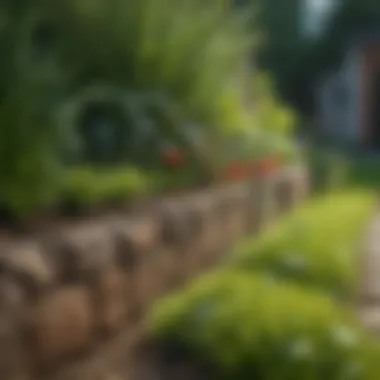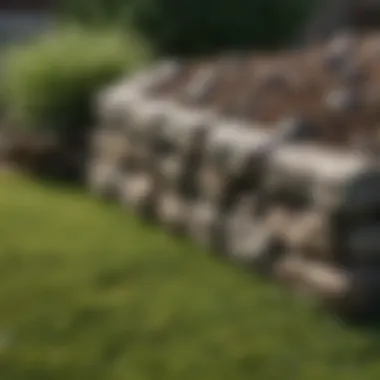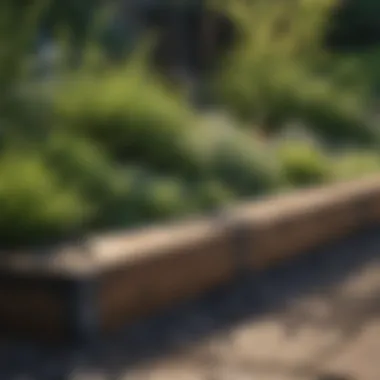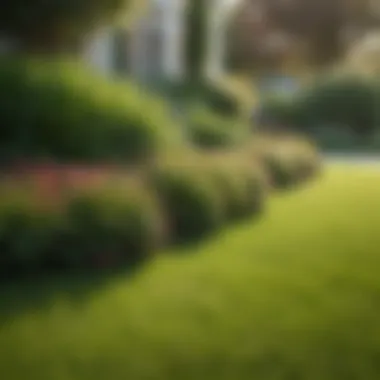Affordable Lawn Edging Solutions for Every Garden


Intro
The pursuit of an aesthetically pleasing garden often leads homeowners to consider lawn edging solutions. Lawn edging serves both functional and decorative purposes. It can delineate borders between different areas of the garden, prevent grass from invading flower beds, and add structure to landscaping. Yet, many homeowners shy away from investing in these features due to perceived high costs. However, there are numerous affordable options available that can significantly enhance the visual appeal of outdoor spaces without breaking the bank.
Affordable lawn edging solutions often utilize materials that are readily accessible and easy to install. This article explores a variety of these solutions, highlighting practical benefits along with tips for installation and maintenance. Understanding the right options can empower homeowners to make informed choices, ultimately leading to an improved garden design that reflects their individual tastes and preferences. Suitable for both novice gardeners and seasoned landscaping enthusiasts, this comprehensive guide aims to illuminate the possibilities of economical lawn edging.
Preamble to Lawn Edging
Lawn edging serves as a functional and aesthetic element for any garden or landscaped area. It defines boundaries, enhances the overall look of outdoor spaces, and plays a role in plant protection. Effective lawn edging is essential for maintaining clean lines between grass and garden beds, preventing grass from overgrowing into flower plots, and vice versa.
Definition of Lawn Edging
Lawn edging can be defined as any material used to create a clear boundary between different sections of a garden. This can include grass, flower beds, pathways, or other landscaping features. Edging materials can vary significantly, ranging from natural elements, like wood and stone, to manufactured options, like plastic and metal. Each type of lawn edging provides unique aesthetic and practical benefits.
Importance of Lawn Edging
The importance of lawn edging extends beyond mere aesthetics. It contributes significantly to garden maintenance and effectiveness. Here are several key reasons for considering lawn edging:
- Boundary Definition: Lawn edging establishes clear separations between areas, guiding the eye and organizing the space.
- Maintenance Ease: Edging reduces the effort required for lawn maintenance. It discourages the encroachment of grass into garden beds, making weeding easier.
- Soil Protection: Proper edging can prevent soil erosion and maintain moisture levels around plants, essential for their health.
- Improved Drainage: Edging can help channel water away from plants, improving drainage in garden beds.
- Aesthetic Appeal: Stylish edging enhances the beauty of the garden, creating a polished and complete appearance.
"Effective lawn edging can not only improve the beauty of your garden but also simplify the maintenance tasks associated with it."
In summary, understanding lawn edging is foundational to developing an attractive and functional outdoor space. It plays an essential role in both design and practicality.
Types of Lawn Edging Materials
When it comes to selecting the right lawn edging materials, homeowners are often faced with a variety of options. Each type of material offers distinct advantages and disadvantages that can influence both aesthetics and functionality. Understanding these options is crucial for making informed decisions, especially when aiming to stay within a budget.
Plastic Lawn Edging
Plastic lawn edging is a popular choice among many homeowners for several reasons. It is lightweight and easy to work with, making installation simple even for those with limited experience. This material is also resistant to weather conditions, which means it will not rust or rot over time. The cost is usually lower compared to other materials, making it a budget-friendly option.
Some considerations include its appearance. Though it can be molded into various shapes, plastic may not provide the same natural look that stone or wood offers. Homeowners might also need to be cautious about durability; while plastic is resistant to some damage, it can become brittle over time when exposed to extreme sunlight. Ultimately, plastic edging can serve its purpose well in many scenarios, especially for those prioritizing ease of use and cost.
Metal Lawn Edging
Metal lawn edging, made of materials like aluminum or steel, provides a sleek and modern look to a garden. Its robust nature ensures that it stands against heavy foot traffic and weather elements without bending or breaking. This durability makes metal edging suitable for both decorative and functional applications.
However, it is essential to consider that metal can be more costly than other types of materials. Installation may also require more effort and some tools, like a mallet or stakes, which could add to the time and expense needed. Additionally, if left untreated, some metals may rust over time, which could impact the overall aesthetic. For those looking for a contemporary finish with durability, metal edging can be an excellent option.
Wooden Lawn Edging
Wooden lawn edging has an organic appeal that can seamlessly blend into any garden or landscape. It offers a traditional and rustic look that can enhance the visual interest of an outdoor space. The cost can vary, but wood is generally available at reasonable prices on the market.
When considering wooden edging, it is critical to examine the quality of the wood. Untreated wood may decay when exposed to moisture and insects, which often results in a shorter lifespan. Pressure-treated wood, however, can resist decay better, but this option may carry a slight premium. The aesthetic charm of wooden edging makes it an inviting choice, particularly when using natural aesthetics are a priority.


Stone and Brick Edging
Stone and brick edging is hailed for its durability and timeless appeal. Natural stone, pavers, and bricks can create a strong border that withstands weathering and wear. Additionally, the options available in terms of color, size, and texture provide homeowners with flexibility in design.
Installation of stone or brick edging can be labor-intensive and may require additional materials like mortar or sand. Although it might incur higher upfront costs, its longevity can make it a cost-effective choice in the long run. Stone and brick edging can firmly establish design boundaries while simultaneously enhancing the overall look of outdoor spaces.
Rubber Lawn Edging
Rubber lawn edging is an innovative choice gaining popularity among budget-conscious gardeners. Made from recycled tires, it is eco-friendly and flexible, which allows for creative designs and curves. It is lightweight, making it easy to install, and its resistance to weather means it won't crack or fade easily with exposure to sun or rain.
The aesthetic may not appeal to everyone, as rubber has a distinct appearance that differs from traditional materials. However, with various designs on the market, including options that mimic the look of wood or brick, it can integrate surprisingly well into many garden themes. Rubber’s affordability and ease of installation make it a compelling option.
"Selecting the right lawn edging material is crucial for achieving the desired look and functionality of your garden space. Each material has merits and drawbacks that cater to different needs."
Cost-Effective Sources for Lawn Edging
Finding cost-effective sources for lawn edging is vital for homeowners seeking to enhance their outdoor spaces on a budget. The right edging can define garden beds, paths, and various features, contributing to a well-structured landscape design. This section explores various sources for obtaining affordable lawn edging materials, considering the benefits, convenience, and types of offerings available at each.
Home Improvement Stores
Home improvement stores like Home Depot and Lowe's are among the best options to consider for lawn edging. They usually carry a wide range of edging materials, from plastic to metal. The advantage of these stores is not only the variety but also the expert advice available. Employees can often provide insights on which products work best for different conditions, such as soil type and climate.
In addition to typical products, these stores frequently offer deals and promotions. Customers can find discounted items or bulk purchasing options that significantly lower costs. Tools and accessories needed for installation are often available as well, making it a one-stop shop for planning an edging project.
Online Retailers
Online retailers like Amazon and Wayfair provide an extensive selection of lawn edging materials, often at competitive prices. The convenience of online shopping cannot be overstated. Customers can browse options from the comfort of their home. A significant benefit of purchasing online is the ability to read reviews from other customers. This feedback helps in assessing the quality and durability of specific products before making a decision.
Shipping options, including free shipping for orders over a certain amount, adds to the appeal. However, it’s crucial to check the return policy since seeing the product first hand isn't possible. This factor can influence the final choice of lawn edging materials.
Local Hardware Stores
Local hardware stores often carry a unique selection of items not found in larger chains. They may stock locally sourced materials, which can be more affordable and in tune with regional landscaping styles. Establishing a relationship with local store owners can lead to valuable advice and even custom solutions tailored to specific needs.
In addition, these stores frequently participate in community initiatives and may offer discounts for residents. Engaging with these local businesses can support the community while improving your landscaping.
Recycled and Repurposed Materials
Using recycled and repurposed materials is not only cost-effective but also environmentally friendly. Materials like reclaimed bricks, logs, or stones can often be sourced at little to no cost from construction sites, junkyards, or online platforms like Craigslist. This approach is also a great way to add character and uniqueness to landscaping.
When considering this option, it's essential to evaluate the condition and suitability of the materials for lawn edging. Some creative ideas include using old wood pallets or creating edging from used tires.
Factors to Consider When Selecting Lawn Edging
Selecting the right lawn edging is crucial for enhancing the visual appeal of a garden. Homeowners should be aware of several key factors that influence their decision. This section will explore four main considerations that can significantly affect the longevity and aesthetics of lawn edging solutions. Understanding these factors allows for informed choices that align with individual preferences and specific garden needs.
Durability and Longevity


Durability is perhaps the most important factor when choosing lawn edging. The chosen material must withstand various weather conditions. For example, plastic edging may warp or fade under intense sunlight, while metals can rust if they are not treated or coated properly. Homeowners should consider the lifespan of the edging material in relation to their local climate.
Investing in more durable options can result in cost savings over time. Although initial expenses for materials like stone may be higher, they often require less frequent replacement. It is wise to weigh initial costs against long-term benefits.
Aesthetic Compatibility
Aesthetics play a vital role in the selection of lawn edging. Homeowners should think about how the edging complements the existing landscape. For instance, a rustic wooden edging may best suit a cottage garden, while sleek metal might fit a modern design better.
Color and style also matter. A uniform look enhances visual cohesion. Choosing an edging that integrates well with plants, pathways, and fences can unify the garden's overall design. Homeowners often seek materials that not only serve a functional purpose but also elevate the beauty of their outdoor space.
Ease of Installation
The complexity of installation can vary significantly from one type of lawn edging to another. Some materials require intricate setups while others offer straightforward, DIY-friendly solutions. For those with limited experience or tools, opting for simpler options may be more practical.
Additionally, homeowners should consider how permanent they want the edging to be. If one plans to change landscaping frequently, temporary edging might be better suited than permanent installations like poured concrete. Researching and potentially watching instructional videos can clarify the installation process, helping in making the right choice.
Maintenance Requirements
Different materials come with varying maintenance needs. Wooden edging, while charming, can rot if not treated regularly. Metal options may need periodic rust prevention treatments. On the contrary, stone and brick require minimal upkeep, proving to be advantageous for busy homeowners.
Regular inspection is essential as well. Edging may shift or degrade over time, especially in high-traffic areas. Homeowners should be prepared to undertake occasional repairs and ensure that the edging remains effective in its role as a separator.
Evaluating durability, aesthetics, installation ease, and maintenance can lead to a rewarding lawn edging choice that meets both practical and aesthetic desires.
By carefully considering these factors, homeowners can select an edging solution that adds value to their property and enhances their outdoor experience.
Installation Methods for Lawn Edging
Proper installation is a critical aspect when it comes to lawn edging. The methods used can impact not only the visual appeal of the garden but also the longevity and functionality of the edging. By addressing the installation approaches thoroughly, homeowners can avoid common pitfalls and ensure that their edging serves its purpose effectively while enhancing the landscape aesthetics.
Trenching for Base Preparation
Before laying any edging material, it is vital to prepare a proper base. Trenching involves digging a narrow channel along the area where the edging will be placed. This process helps shape the landscape and ensures that the edging sits securely, preventing movement over time. When trenching, homeowners need to consider the following:
- Depth and Width: Generally, a depth of about three to four inches is sufficient for most materials. The width should allow enough space for the edging to fit snugly without being overly loose.
- Soil Conditions: Depending on the soil type, adjustments may need to be made. Sandy soils can hold edging better than clay, which may require more preparation.
- Slope Alignment: If the garden has uneven terrain, it's advisable to adjust the trench accordingly. This helps in maintaining a uniform look, avoiding gaps that may detract from the garden’s appearance.
By meticulously preparing the edge with a well-defined trench, homeowners ensure that the lawn edging has a solid foundation that supports both stability and aesthetics.
Securing Edging Materials
Once the trench is ready, the next step is to place and secure the edging materials. Different edging types may require varying methods of securing. Properly securing the materials is essential to ensure they do not shift over time, which could leave the garden looking unkempt. Here are some methods to consider:
- Staking or Pinning: For flexible materials such as plastic or rubber edging, metal stakes can be used to keep the edging in place. These should be driven deep into the ground next to the material to prevent shifting.
- Concrete: If using stone or brick edging, consider mixing concrete to provide additional strength. Fill in any gaps with soil or gravel after securing.
- Gravity: Heavier materials like stones may utilize their weight to stay in position. However, it is still advisable to use a little bit of soil or fine gravel to fill around them for extra support.
Following these practices ensures that the edging will stay where it should, maintaining an organised and beautiful garden space.
Adding Mulch or Gravel


After the edging materials are in place, adding mulch or gravel serves several purposes. This step not only enhances the aesthetic appeal, but it also benefits the garden in practical ways:
- Moisture Retention: Mulch helps to retain moisture in the soil. This is important for plant health, especially in hotter months.
- Weed Suppression: A layer of mulch can minimize weed growth by blocking sunlight. This reduces competition for nutrients and water among plants.
- Visual Appeal: Different colors and types of mulch and gravel can complement the edging and the overall garden design.
Homeowners can choose between organic mulch (like wood chips) and inorganic options (such as gravel) based on their garden's needs and aesthetic preferences.
Maintenance of Lawn Edging
Maintaining lawn edging is essential for preserving the integrity and aesthetic appeal of outdoor spaces. Proper care can extend the lifespan of the materials used and help maintain a clean, defined boundary between lawns and gardens. Neglecting maintenance can lead to deterioration, damage, and an unkempt look, which could ultimately detract from the investment made in these solutions.
A regular maintenance routine not only ensures that lawn edging performs its intended function but also enhances the overall appearance of the landscape. Homeowners can gain several benefits from diligently maintaining their lawn edging, such as improved curb appeal and the prevention of plant overgrowth. Here are key aspects to consider:
- Durability: Regular maintenance can identify any potential damage early, reducing the need for more significant repairs or replacements.
- Aesthetic Value: Well-maintained edging complements garden designs, offering a polished and structured look.
- Cost Effectiveness: Routine upkeep can save money in the long run by preventing costly repairs.
By employing straightforward and systematic methods, homeowners can effectively care for their lawn edging.
Regular Inspection and Repair
Frequent inspection of lawn edging materials is vital to catch wear and tear before they escalate into larger issues. Homeowners should look for cracks, shifts, or corrosion, depending on the type of edging. For instance, plastic edging can become brittle over time, while metal might show signs of rust.
Simple repairs can often be executed with minimal effort and costs, such as:
- Reinforcing loose sections: For concrete or stone edging, using adhesive or mortar can help secure any loose stones back in place.
- Replacing damaged pieces: If a section of edging is severely cracked or broken, replacing just that piece can be simpler and cheaper than a full replacement of the entire edging.
- Adjusting alignment: Over time, edging may shift from its original position. Regular adjustment keeps it visually appealing and functional.
Cleaning Techniques
Maintaining cleanliness is another crucial part of lawn edging upkeep. Accumulated dirt, grass clippings, and other debris can lead to discoloration and may even promote rot in certain materials like wood. Here are some effective cleaning techniques:
- Washing: A simple spray with a garden hose or pressure washer can remove stubborn dirt. Ensure that water does not splash onto adjacent plant beds where it could disturb soil or plants.
- Scrubbing: For more persistent stains or algae growth on materials like stone or concrete, a stiff brush and mild soap can be effective.
- Sealing: Consider applying a sealant to wooden edging after cleaning for added protection against moisture and pests.
Seasonal Adjustments
Different seasons bring various challenges for lawn edging maintenance. Seasonal adjustments are necessary to adapt to weather changes, prevent damage, and promote longevity.
- Spring check: After winter, check for any heaving caused by frost. Adjustments might be needed to reposition or replace sections of the edging.
- Summer care: In hot weather, inspect for warping or drying out, especially in wood materials. Keeping plants and grass trimmed back will prevent encroachment.
- Autumn cleanup: Remove any debris around the edging to avoid mold and mildew growth. This is also a good time to repair any damage that may have occurred over the summer months.
- Winter preparation: Prepare edging for cold months by checking connections and securing loose pieces before snow accumulation occurs.
Regular maintenance is the key to longevity. Simple inspections, cleaning, and seasonal adjustments can help save time and money in the long run.
End
In this article, the conclusion serves as a crucial wrap-up of the various aspects of affordable lawn edging solutions discussed previously. This section synthesizes the information, emphasizing the importance of making informed decisions when selecting the right materials for lawn edging. Affordable solutions do not merely serve as practical barriers; they also enhance the overall aesthetic appeal of gardens and landscapes.
Recap of Key Points
The key points discussed in the article can be summarized as follows:
- Definition and Importance: Lawn edging is essential for creating defined lines in landscaping, preventing soil erosion, and maintaining garden integrity. It enhances the visual organization of outdoor spaces.
- Material Options: Various materials like plastic, metal, wood, stone, and rubber offer different aesthetic and functional benefits. Each type provides unique advantages tailored to specific garden styles and budgets.
- Cost-Effective Sources: Home improvement stores, online retailers, and local hardware stores provide accessible options. Additionally, recycled materials present an eco-friendly alternative that could lead to further savings.
- Selection Considerations: Durability, aesthetic compatibility, ease of installation, and maintenance are key factors that guide homeowners in choosing the right lawn edging.
- Installation Methods: Proper installation ensures longevity and effectiveness. Techniques like trenching and securing materials properly are vital for successful outcomes.
- Maintenance Practices: Regular inspection, cleaning techniques, and seasonal adjustments help in maintaining the functionality and appearance of lawn edging.
Final Thoughts on Cost-Effectiveness
Considering cost-effectiveness in lawn edging is vital for homeowners on a budget. With thoughtful choice of materials and careful planning, it is possible to achieve attractive and durable landscape definitions without financial strain. The discussion emphasizes that enhancements in outdoor spaces do not need to come at a high price. Simple measures, such as utilizing local resources or opting for recycled materials, can yield a beautiful garden without exceeding budgetary constraints.
Ultimately, the right lawn edging can transform any space. By weighing the practical benefits against costs and considering personal preferences, homeowners can create lasting impressions that elevate their outdoor living areas.















